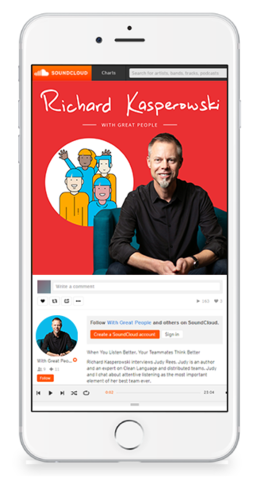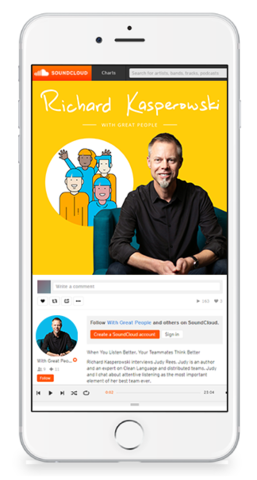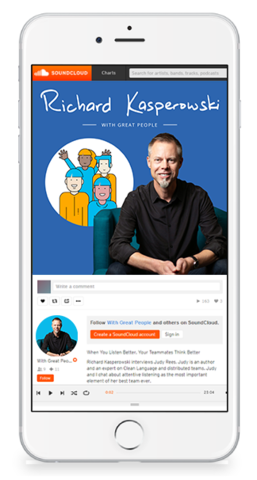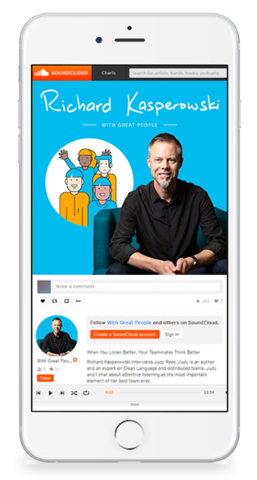Categories
Esther Derby: How to Keep Your Team Connected and Focused?
In this episode, Richard interviews Esther Derby, one of the world’s top experts in organizational dynamics. Esther coauthored three books, including Behind Closed Doors with Johanna Rothman and Agile Retrospectives with Diana Larsen and Ken Schwaber. In her newest book – Seven Rules for Positive Productive Change – Esther is exploring growth mentality through seven problem-solving techniques. Esther shares with us the secret of how to keep a team connected, inclusive, and engaging. When you finish listening to the episode, make sure to visit Esther’s website and connect with her on Twitter and LinkedIn.
Esther Derby: How to Keep Your Team Connected and Focused?
with Esther Derby
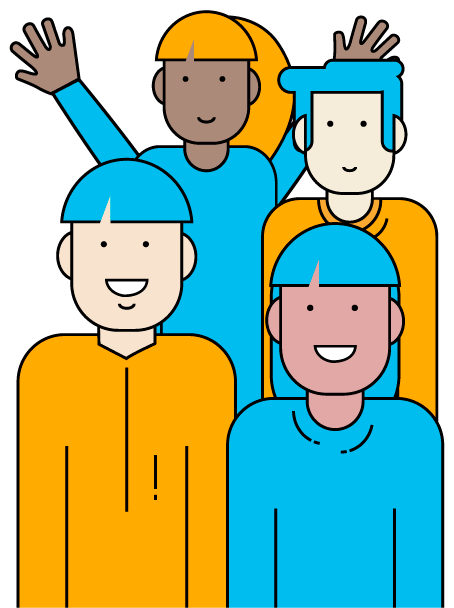
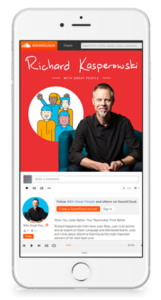
TRANSCRIPT
Richard 00:11
Hi, friends. Welcome back to With Great People, the podcast for high performance teams. I’m Richard Kasperowski. You’ve probably heard the expression, too many cooks spoil the broth. Is that what happens to successful teams or companies? Is that why they lose their effectiveness when they become too large to manage? In this episode, I talk with Esther Derby, one of the world’s top experts in organizational dynamics, about how to keep your work environment more humane, compact, and inclusive. To support this podcast, visit my website, kasperowski.com.
Richard: (00:45)
And today, we have Esther Derby as our guest. Hi, Esther. How are you?
Esther: (00:56)
Hey, I’m great.
Richard: (00:57)
Esther, could you introduce yourself to our listeners?
Esther: (00:59)
Sure. I started my career as a programmer, which some people don’t know, but I actually programmed for quite a few years. And because we all used to test our own code, I also did testing. It was before that great divide, that great and artificial divide. I was a team lead, and because I was good at all of those things, they made me a manager, which is a completely different set of skills. I had to learn a bunch of different stuff. And since 1997, I’ve had my own company helping people develop software in a better way and make workplaces more humane.
Richard: (01:39)
Awesome. Thanks for being here.
Esther: (01:41)
Yeah, my pleasure.
Richard: (01:43)
This is the podcast about teams and the podcast about the best teams of your life. So what I like to do is ask people about the best team of their life. What is the best team of your life? This could be any group of two or more people that you care about, any group of tumor people who had a common goal. What’s the best one of those that you had in your entire life?
Esther: (02:04)
My entire life? That causes me to think back over many, many years. I would say one of the best teams I was ever on was the team that put together the iConference.
Richard: (02:14)
Okay.
Esther: (02:16)
It was a conference that ran for, I think, 12 or 13 years. We started it in 2000 in response to our lack of enthusiasm for the sort of conferences that we had been experiencing, which were 45 minute sessions of someone talking at you from PowerPoint slides and separating the speakers from the participants and certifications and all of these things. So we wanted to do a conference that would be experiential and where there was plenty of time for interactions between the people who are putting on the conference and the people who are participating in the conference, because we viewed ourselves as participants and customers of the conference as well as people who were putting it on. So it was a great team and we had a long run.
Richard: (03:05)
All right. What else about this team?
Esther: (03:06)
Well, we dealt with a lot of problems. I think that’s worth pointing out because people often think, oh, teamwork, la, la, la. It’s just wonderful. It’s not always just wonderful. We had some tough times, and we had to deal with a membership that was too large. There was just too many people on the team, so some people self-selected of, some people were encouraged to find something else, some other focus in their life. So we figured out how to deal with those things and regroup after. Sometimes teams can’t figure out a way forward after they’ve had a bit of a tough time. So I think that was a unique hallmark of this team.
Richard: (03:54)
All right. If you could take yourself back to this team, and sometimes this is like a guided meditation almost, sometimes you can close their eyes, if you take yourself back to this team and sort of relive the work you were doing together, relive the interactions with the people on the team and really re-experience what was happening, could you summarize the sensation of that experience in a single word?
Esther: (04:21)
Connected.
Richard: (04:22)
Connected. All right.
Esther: (04:24)
Yeah. We were connected.
Richard: (04:26)
What was connected like for you and that team?
Esther: (04:29)
It felt like… The word that’s coming to mind is anchor, and I don’t mean that in that it weighed us down. This was a constant and kind of a home place in my life for 12 years. That this was a group of people I knew I’d be in connection with and working closely with.
Richard: (04:50)
What was that connection like?
Esther: (04:52)
Some of my greatest friendships and some of my greatest partnerships came out of that team. So we did this thing together. We put on this conference together, but I also wrote a book with one of the other people on this team. I have taught workshops with people who were on this team. And so it led to a lot of really interesting and rich collaborations in different configurations.
Richard: (05:18)
All right. Now, subjectively or objectively, other things you experienced or other things somebody else could observe from the outside? How did you know that this was a great team?
Esther: (05:30)
Two things stand out for me. We put out a great product. The iConference was for its time unique, and I think it had an influence on many other conferences in that it made it seem feasible to people that, oh, we could really do experiential sessions. And it opened up a different avenue for people to say, “I don’t want to just listen to talking heads. I want to actually be involved and active in the learning.” So I think we actually brought some change.
Richard: (05:59)
Definitely.
Esther: (06:00)
And we demonstrated that something else was possible. I learned a ton. And I think that for me, those are two really important things about a team. You create a good product, a great product, and you learn while you do it.
Richard: (06:15)
I love that. And what’s going on in my head right now is I’m thinking about all of the things that I love about conferences and when I help produce conferences today and the way I share things with people, it’s all about experience and experiential learning and sharing. I’m certain I was unwittingly influenced by the work you and this team did.
Esther: (06:35)
Well, that’s nice to hear. You just never know how things are going to ripple out into the universe.
Richard: (06:41)
And I’m grateful for that, so thank you. Now, what were some of the concrete behaviors that this team did? This was a pretty long lived team I guess.
Esther: (06:49)
Yeah, it was.
Richard: (06:50)
What are some of the concrete behaviors of this team that led to its success?
Esther: (06:55)
We rotated, so we were not in the same roles. We didn’t have the same sort of focus for the whole time. We were very conscious about choosing someone each year, and each year it was a different person who would have the big picture responsibilities. So making sure all of the parts of it were coming together as they needed to. And then within the various aspects of putting on a conference, we rotated that responsibility. So we all got to learn a lot, right? We all got to learn different aspects of putting on a conference and dealing with hotels and how to put together content and how to increase our ability to do really effective experiential workshops. We designed to learn.
Esther: (07:49)
Our team was designed so that we could all be learning, and I think that’s super important. So we rotated. It was designed to learn. And I say this because I saw the contrast of when this behavior was absent. We had a habit of doing appreciations at the beginning of every meeting, and we did it in a particular way, name a person I appreciate you for and whatever we appreciated them for. And we did this for a number of years. And then for whatever reason or no reason or who knows why, one year we didn’t do it and the tone of our meetings changed completely.
Richard: (08:32)
Interesting.
Esther: (08:33)
Yeah. It was super interesting. I mean, people were shorter with each other. They were more inclined to be sharp if something hadn’t worked out exactly or someone hadn’t gotten something done that they thought they were going to get done. And I asked, can we start doing this again, because I was not the big picture person that year. And so we started doing appreciations again and the tone changed.
Richard: (08:59)
It’s so interesting. It was like [inaudible 00:09:01]
Esther: (09:03)
It was fascinating. Because in any project, things aren’t going to go exactly as planned and somebody may screw up and somebody may miss a date. But when we had the practice of appreciations, even though we could call people on stuff, we also knew that we valued each other, and we affirmed that we valued each other each and every meeting. These were all remote meetings or mostly remote meetings. But that practice of making it clear and making it explicit that we valued each other really had a big effect on the interactions.
Richard: (09:44)
I can totally see that and how that changes things. I’m dealing with issues like this on a team that I’m part of that’s in the agile community that helps run conferences.
Esther: (09:54)
Sure.
Richard: (09:55)
We’ve got a little bit of disintegration happening right now and a lot of people not feeling appreciated I guess. This would be a really good habit for us to get into.
Esther: (10:04)
It’s worth a try. The other thing that I think we did well was we knew when to stop, which is another thing. I think particularly with teams that are brought together not by some external force, but because they want to do something together, sometimes you just keep going on and on and on when the energy has shifted. And so we recognized when we were ready to stop, and it was like, we love the conference, but we’ve learned what we wanted to learn. And we’ve had some influence in the way conferences are done, and so let’s find something else to do.
Richard: (10:44)
In addition to that, what about the… Earlier you mentioned something about the team size and the team being too big at some point.
Esther: (10:51)
17 people.
Richard: (10:52)
17 people.
Esther: (10:54)
17 people. That was crazy. Yeah, that was crazy.
Richard: (11:01)
So what was that like? I mean, people often ask people like us, what’s the best size for a team? What’s the best number of people? The answer is never 17.
Esther: (11:08)
No, it’s never 17. Well, unless the work requires 17 people and this work did not, which meant there was an interesting social ripple effect from that in that people either didn’t have something to contribute because there wasn’t room for them, and so they would try to contribute, but not always in ways that were super effective, or people would not be contributing because there wasn’t so much place for them. And then people would wonder, well, what are your motives? It actually was not an ideal situation, right? Because the work just really didn’t require that many people and yet people want to contribute. So it led to a lot of additional coordination and vastly more relationships to manage and vastly more communication paths.
Richard: (12:01)
What did you learn about teams and team size? How did you deal with resolving conflict?
Esther: (12:10)
Look at the amount of work that needs to be done and don’t have more people than that, right? Because there will be natural cleavages then, right? People will try to find a way to contribute not always in the best possible way. And it’s more likely that when it’s not possible for everybody to be like laser focused on the purpose or the outcome you’re trying to do, it’s much easier for people to break down into subgroups. I mean, I think any group that big it’s likely that people are going to break it down into subgroups or people will drift towards the periphery. It doesn’t mean they’re bad people. It’s just a phenomena of a group that size with work that doesn’t really need 17 people.
Richard: (12:54)
Yeah. I have more curiosity about this. What was the minimum size of the group, maximum size of the group, what number of people seems like the right number for the work that your group had?
Esther: (13:04)
At the end, there were four of us. And because we’d been doing it, it wasn’t a lot of discovery in the work at that point. So it was possible for four people to do it. We had a couple of contractors that helped us with some of the logistical stuff, but yeah. So we went from 17 to four. I don’t think three would have been ideal.
Richard: (13:27)
Now, are there any other concrete behaviors that went into this team and the awesome work that you did together?
Esther: (13:35)
He made sure that we got together face to face at least one time outside of the conference. So we had a way to deal with some of the more ambiguous aspects of our work face to face and do some planning face to face. We generally had fairly good protocols about our remote meetings because all our meetings were on the phone. And we weren’t using video much at that point, so it was really all on the phone. And we planned time both before the conference to connect and after the conference to reflect. So that connect and reflect I think was really important.
Richard: (14:11)
And what did connect look like? What did reflect look like?
Esther: (14:14)
Connect meant having meals together, talking about what we were hoping for for the conference, talking about what our wishes were, what we wanted to learn. Just catching up on what we’d been up to. It was just connecting as humans, as well as connecting about the work of the conference and making sure everything was ready to go.
Richard: (14:38)
And then afterward, the reflect?
Esther: (14:40)
We did various forms of retrospectives, sometimes more formal, sometimes less formal, and the insights we had went immediately into the planning for the next conference.
Richard: (14:53)
All right. Now, what about podcast listeners? What advice would you give them to reproduce some of this team’s success?
Esther: (15:00)
Design for learning. I think that is super important. If you are not focusing on learning as well as execution, you may still learn stuff, but it’s going to be more haphazard, and it’s not as likely to be folded back into the work of the team. So think about learning as part of your goal. That’s part of my definition of a team. They do a great product and they’re even more capable because of their work together so that they’ve learned as they went together.
Richard: (15:33)
All right. Design for learning. Are there tips for the design part of that?
Esther: (15:39)
Well, what we did on that was we consciously rotated roles. We consciously said, “Okay, we’re going to pair on this thing. So I’ve done it before and you’re doing it for the first time,” which that was only true after several years because we all rotated through. So we paired, we rotated, we made sure that we didn’t have a single point of failure. So I think those are all things that are useful for designing for learning.
Richard: (16:06)
Yeah. All right.
Esther: (16:08)
And then having a practice of reflection. So we really did have just one delivery, which was conference, so it made sense to have that one reflection about at the conference level. But we had many reflections all the way along. I think those are things to keep in mind.
Richard: (16:27)
All right. Is there anything else you’d like to add? Is there anything you’re working on right now, anything you’re passionately sharing you want to make sure listeners hear about?
Esther: (16:34)
I have been experimenting with making some online courses. So that’s been super fun. So you could go to estherderby.teachable.com to see those, or you can just go to my website, estherderby.com, and you’ll find out about all the workshops I do. I’m still super excited to be doing PSL, Problem Solving Leadership. Got some writing projects on the back burner. I had a book come out in August, so that might be interesting to people, 7 Rules for Positive, Productive Change: Micro Shifts, Macro Results, available wherever fine books are sold and on Amazon. So yeah, just keep it on.
Richard: (17:11)
All right. We’ve got estherderby.com. If people want to reach out to you, is that the best way for people to find you?
Esther: (17:18)
That’s a great way to find me. I can also be found on Twitter. I actually like Twitter, so Esther Derby on Twitter. That’s because I don’t do politics on Twitter.
Richard: (17:27)
Right.
Esther: (17:27)
I think if I did politics on Twitter, I might not like it as much.
Richard: (17:31)
It’s the funniest place.
Esther: (17:33)
I’m also on LinkedIn, so you can find me there.
Richard: (17:36)
All right. It’s almost apologetic, it’s funny. I actually like Twitter.
Esther: (17:41)
I do like Twitter. So when Twitter was new and I had like 500 followers, it was possible to recognize people from Twitter. I’d go some place and would be, I know you from Twitter. I was in Japan one time and this guy held up his little avatar and I said, “I know that avatar.” When it was small, it was really fun in that way. And now it’s just I get to have really interesting interactions with a lot of people.
Richard: (18:09)
Well, Esther, thank you so much for joining us today. I really, really, truly appreciate it. Thank you.
Esther: (18:15)
Yeah, my pleasure. Nice to talk with you.
Richard: (18:22)
Hi, friends. Thanks again for listening. And remember



